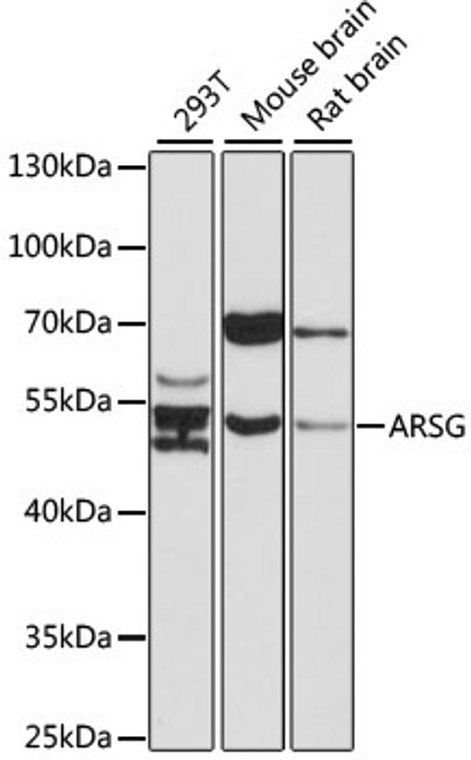| Host: |
Rabbit |
| Applications: |
WB |
| Reactivity: |
Human/Mouse/Rat |
| Note: |
STRICTLY FOR FURTHER SCIENTIFIC RESEARCH USE ONLY (RUO). MUST NOT TO BE USED IN DIAGNOSTIC OR THERAPEUTIC APPLICATIONS. |
| Short Description: |
Rabbit polyclonal antibody anti-ARSG (376-525) is suitable for use in Western Blot research applications. |
| Clonality: |
Polyclonal |
| Conjugation: |
Unconjugated |
| Isotype: |
IgG |
| Formulation: |
PBS with 0.01% Thimerosal, 50% Glycerol, pH7.3. |
| Purification: |
Affinity purification |
| Dilution Range: |
WB 1:500-1:2000 |
| Storage Instruction: |
Store at-20°C for up to 1 year from the date of receipt, and avoid repeat freeze-thaw cycles. |
| Gene Symbol: |
ARSG |
| Gene ID: |
22901 |
| Uniprot ID: |
ARSG_HUMAN |
| Immunogen Region: |
376-525 |
| Immunogen: |
Recombinant fusion protein containing a sequence corresponding to amino acids 376-525 of human ARSG (NP_001254656.1). |
| Immunogen Sequence: |
AQASLPQGRRFDGVDVSEVL FGRSQPGHRVLFHPNSGAAG EFGALQTVRLERYKAFYITG GARACDGSTGPELQHKFPLI FNLEDDTAEAVPLERGGAEY QAVLPEVRKVLADVLQDIAN DNISSADYTQDPSVTPCCNP YQIACRCQAA |
| Tissue Specificity | Widely expressed, with very low expression in brain, lung, heart and skeletal muscle. |
| Post Translational Modifications | N-glycosylated. N-glycosylated with both high mannose and complex type sugars. The conversion to 3-oxoalanine (also known as C-formylglycine, FGly), of a serine or cysteine residue in prokaryotes and of a cysteine residue in eukaryotes, is critical for catalytic activity. The 63-kDa precursor undergoes proteolytic processing in two steps, yielding two fragments in the first step (apparent molecular masses of 44 and 18 kDa). In the second step, the 44-kDa fragment is processed further to the 34- and 10-kDa chains. The 10-kDa chain is a cleavage product of the 44-kDa fragment but linked to the 18-kDa chain through a disulfide bridge. |
| Function | Displays arylsulfatase activity at acidic pH towards artificial substrates, such as p-nitrocatechol sulfate and also, but with a lower activity towards p-nitrophenyl sulfate and 4-methylumbelliferyl sulfate. Catalyzes the hydrolysis of the 3-sulfate groups of the N-sulfo-D-glucosamine 3-O-sulfate units of heparin. |
| Protein Name | Arylsulfatase GAsgN-Sulfoglucosamine-3-Sulfatase |
| Database Links | Reactome: R-HSA-1660662Reactome: R-HSA-1663150 |
| Cellular Localisation | LysosomeThe 63-Kda Precursor Protein Localizes To Pre-Lysosomal Compartments And Tightly Associates With Organelle MembranesMost Likely The Endoplasmic ReticulumIn ContrastProteolytically Processed Fragments Of 34-18- And 10-Kda Are Found In Lysosomal Fractions And Lose Their Membrane Association |
| Alternative Antibody Names | Anti-Arylsulfatase G antibodyAnti-Asg antibodyAnti-N-Sulfoglucosamine-3-Sulfatase antibodyAnti-ARSG antibodyAnti-KIAA1001 antibodyAnti-UNQ839 antibodyAnti-PRO1777 antibody |
Information sourced from Uniprot.org
12 months for antibodies. 6 months for ELISA Kits. Please see website T&Cs for further guidance







